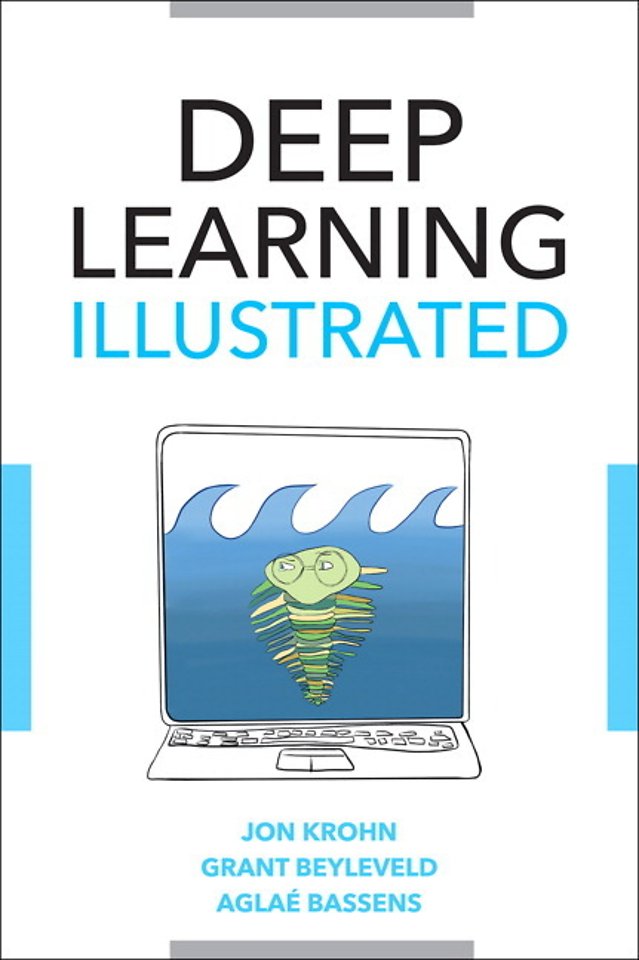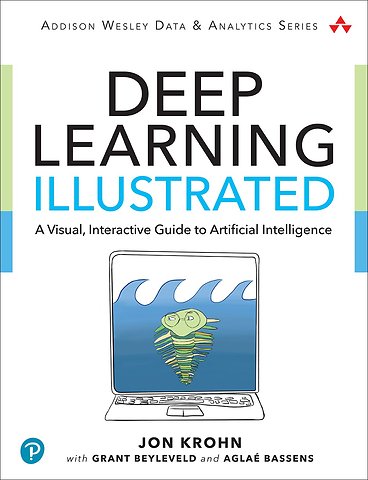


Jon Krohn is Chief Data Scientist at the machine learning startup untapt. He presents an acclaimed series of tutorials published by Addison-Wesley, including Deep Learning with TensorFlow and Deep Learning for Natural Language Processing.
Meer over de auteursDeep Learning Illustrated
A Visual, Interactive Guide to Artificial Intelligence
Paperback Engels 2019 1e druk 9780135116692Samenvatting
'The authors’ clear visual style provides a comprehensive look at what’s currently possible with artificial neural networks as well as a glimpse of the magic that’s to come.' - Tim Urban, author of 'Wait But Why Fully Practical, Insightful Guide to Modern Deep Learning'
Deep learning is transforming software, facilitating powerful new artificial intelligence capabilities, and driving unprecedented algorithm performance. Deep Learning Illustrated is uniquely intuitive and offers a complete introduction to the discipline’s techniques. Packed with full-color figures and easy-to-follow code, it sweeps away the complexity of building deep learning models, making the subject approachable and fun to learn.
World-class instructor and practitioner Jon Krohn—with visionary content from Grant Beyleveld and beautiful illustrations by Aglaé Bassens—presents straightforward analogies to explain what deep learning is, why it has become so popular, and how it relates to other machine learning approaches. Krohn has created a practical reference and tutorial for developers, data scientists, researchers, analysts, and students who want to start applying it. He illuminates theory with hands-on Python code in accompanying Jupyter notebooks. To help you progress quickly, he focuses on the versatile deep learning library Keras to nimbly construct efficient TensorFlow models; PyTorch, the leading alternative library, is also covered.
You’ll gain a pragmatic understanding of all major deep learning approaches and their uses in applications ranging from machine vision and natural language processing to image generation and game-playing algorithms.
Discover what makes deep learning systems unique, and the implications for practitioners
Explore new tools that make deep learning models easier to build, use, and improve
Master essential theory: artificial neurons, training, optimization, convolutional nets, recurrent nets, generative adversarial networks (GANs), deep reinforcement learning, and more
Walk through building interactive deep learning applications, and move forward with your own artificial intelligence projects
Specificaties
Lezersrecensies
Over Beyleveld Grant
Over Bassens Aglae
Inhoudsopgave
Tables xxvii
Examples xxix
Foreword xxxiii
Preface xxxv
Acknowledgments xxxix
About the Authors xli
Part I: Introducing Deep Learning 1
Chapter 1: Biological and Machine Vision 3
Biological Vision 3
Machine Vision 8
TensorFlow Playground 17
Quick, Draw! 19
Summary 19
Chapter 2: Human and Machine Language 21
Deep Learning for Natural Language
Processing 21
Computational Representations of Language 25
Elements of Natural Human Language 33
Google Duplex 35
Summary 37
Chapter 3: Machine Art 39
A Boozy All-Nighter 39
Arithmetic on Fake Human Faces 41
Style Transfer: Converting Photos into Monet (and Vice Versa) 44
Make Your Own Sketches Photorealistic 45
Creating Photorealistic Images from Text 45
Image Processing Using Deep Learning 46
Summary 48
Chapter 4: Game-Playing Machines 49
Deep Learning, AI, and Other Beasts 49
Three Categories of Machine Learning Problems 53
Deep Reinforcement Learning 56
Video Games 57
Board Games 59
Manipulation of Objects 67
Popular Deep Reinforcement Learning Environments 68
Three Categories of AI 71
Summary 72
Part II: Essential Theory Illustrated 73
Chapter 5: The (Code) Cart Ahead of the (Theory)
Horse 75
Prerequisites 75
Installation 76
A Shallow Network in Keras 76
Summary 84
Chapter 6: Artificial Neurons Detecting Hot Dogs 85
Biological Neuroanatomy 101 85
The Perceptron 86
Modern Neurons and Activation Functions 91
Choosing a Neuron 96
Summary 96
Key Concepts 97
Chapter 7: Artificial Neural Networks 99
The Input Layer 99
Dense Layers 99
A Hot Dog-Detecting Dense Network 101
The Softmax Layer of a Fast Food-Classifying Network 106
Revisiting Our Shallow Network 108
Summary 110
Key Concepts 110
Chapter 8: Training Deep Networks 111
Cost Functions 111
Optimization: Learning to Minimize Cost 115
Backpropagation 124
Tuning Hidden-Layer Count and Neuron
Count 125
An Intermediate Net in Keras 127
Summary 129
Key Concepts 130
Chapter 9: Improving Deep Networks 131
Weight Initialization 131
Unstable Gradients 137
Model Generalization (Avoiding Overfitting) 140
Fancy Optimizers 145
A Deep Neural Network in
Keras 147
Regression 149
TensorBoard 152
Summary 154
Key Concepts 155
Part III: Interactive Applications of Deep Learning 157
Chapter 10: Machine Vision 159
Convolutional Neural Networks 159
Pooling Layers 169
LeNet-5 in Keras 171
AlexNet and VGGNet in Keras 176
Residual Networks 179
Applications of Machine Vision 182
Summary 193
Key Concepts 193
Chapter 11: Natural Language Processing 195
Preprocessing Natural Language Data 195
Creating Word Embeddings with word2vec 206
The Area under the ROC Curve 217
Natural Language Classification with Familiar Networks 222
Networks Designed for Sequential Data 240
Non-sequential Architectures: The Keras Functional API 251
Summary 256
Key Concepts 257
Chapter 12: Generative Adversarial Networks 259
Essential GAN Theory 259
The Quick, Draw! Dataset 263
The Discriminator Network 266
The Generator Network 269
The Adversarial Network 272
GAN Training 275
Summary 281
Key Concepts 282
Chapter 13: Deep Reinforcement Learning 283
Essential Theory of Reinforcement Learning 283
Essential Theory of Deep Q-Learning Networks 290
Defining a DQN Agent 293
Interacting with an OpenAI Gym Environment 300
Hyperparameter Optimization with SLM Lab 303
Agents Beyond DQN 306
Summary 308
Key Concepts 309
Part IV: You and AI 311
Chapter 14: Moving Forward with Your Own Deep Learning Projects 313
Ideas for Deep Learning Projects 313
Resources for Further Projects 317
The Modeling Process, Including Hyperparameter Tuning 318
Deep Learning Libraries 321
Software 2.0 324
Approaching Artificial General Intelligence 326
Summary 328
Part V: Appendices 331
Appendix A: Formal Neural Network Notation 333
Appendix B: Backpropagation 335
Appendix C: PyTorch 339
PyTorch Features 339
PyTorch in Practice 341
Index 345
Anderen die dit boek kochten, kochten ook
Rubrieken
- advisering
- algemeen management
- coaching en trainen
- communicatie en media
- economie
- financieel management
- inkoop en logistiek
- internet en social media
- it-management / ict
- juridisch
- leiderschap
- marketing
- mens en maatschappij
- non-profit
- ondernemen
- organisatiekunde
- personal finance
- personeelsmanagement
- persoonlijke effectiviteit
- projectmanagement
- psychologie
- reclame en verkoop
- strategisch management
- verandermanagement
- werk en loopbaan





